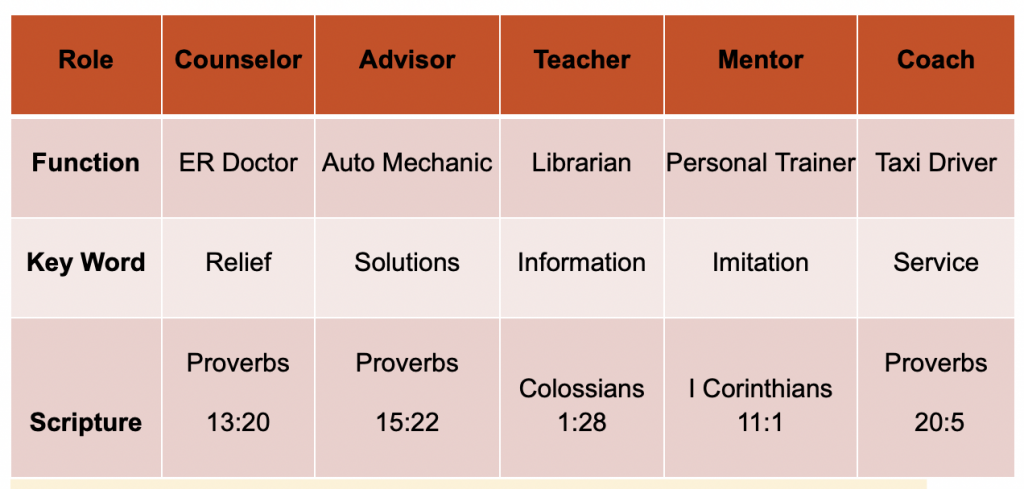You heard it here… coaching is not always the best approach. There are times when, as a coach, you will need to switch hats in order to meet the needs of your clients. Let’s dive into the when and how.
When you have a problem with your car, you need a mechanic to diagnose and fix it. If you slice your finger, you need a doctor. When you need a ride to the airport, you call an Uber. Different needs require certain expertise.
The 5 Hats You’ll Wear as a Coach
The table below was shared by my friend Micah Dodson of www.thrivechurchplanting.org. I personally found the descriptions of each role helpful to distinguish one from the other. These roles can easily blur into each other, especially if you have a background in teaching, counseling or mentoring and are now adding coaching into your toolkit. A key point to being a new coach is to learn to be clear in your mind when you are functioning in a particular role, or it will confuse and potentially frustrate those you are attempting to help.

Each role has a specific function. Here are the functions along with the scripture reference. Look below and contemplate which ones you resonate with:
Counselor
Walk with the wise and become wise, for a companion of fools suffers harm. / Proverbs 13:20
Advisor
Plans fail for lack of counsel, but with many advisers they succeed. / Proverbs 13:20
Teacher
He is the one we proclaim, admonishing and teaching everyone with all wisdom, so that we may present everyone fully mature in Christ. / Colossians 1:28
Mentor
Follow my example, as I follow the example of Christ. / I Corinthians 11:1
Coach
The purposes of a person’s heart are deep waters, but one who has insight draws them out. / Proverbs 20:5
*All scripture passages from NIV
You Can Over-Coach
A classic problem I faced parenting my kids, I over-coached them. This surfaced when they were home as young adults during COVID. I was using questions to help them challenge them to “do something”. My approach was making them suspicious of my intent. I was using key questions to help them come around and do something I wanted them to do, in the way I wanted them to do it. Manipulation is not the intent of coaching. But that is how it came across. Fortunately, my family pointed this out and I became more aware of what I was doing.
This raises a few important questions that arise when I am training leaders in coaching:
- Is coaching always the best approach?
- What cues should we look for to determine when to use another approach?
- How to make the shift from one approach to another without confusing clients?
Is coaching always the best approach?
No, but I’ve found the more we can use a coach approach, the better. Realistically, you can blend coaching into each of the other four roles above. I view coaching on a continuum. One end of the continuum is Directive and the other end, Non-directive. The more Non-directive approach, the more likely we can help people discover for themselves. The goal is for the client to feel empowered to take action.
Of course, when you play that out in each role, it becomes obvious when you need to stop asking questions. You need to learn to be aware of what the client needs at the moment! For example, if I take a bad fall on my mountain bike, I need to go to the ER. The only question I want to ask is – “Which way to the hospital?”
What cues should we look for to determine when to use another approach?
The simple answer is when it stops working; like in my example with my kids. At the peak of frustration, they gave me explicit feedback: “Just tell us what you want us to do!” Below are some ques to look for when coaching so it doesn’t go this far:
- Frustration – you are agitating your client more than helping
- Silence – this can be a sign that your client really does not know what to do
- Lack of follow-through; the client in not engaged
How to make the shift from one approach to another without confusing clients?
I’ve found that being clear with what role you are playing is respectful to the client – and critical for you. When it is murky in your mind personally, it can be confusing or frustrating for the client. For example, when a client comes to you for advice and you are operating as a coach, then you are going to approach the conversation differently than your client.
For example, let’s assume you have been serving a client as a coach but you also have the capacity to switch into counselor mode. When you make the switch it is helpful to signal your client about the switch. This can be simply saying something like, “I’m taking off my coaching hat and now putting on my counselor hat.”
This will have several benefits. First, it will reinforce the shift you are making. Second, it will communicate a shift in the tone of the conversation. Third, it has the potential to accelerate the conversation. The caution here is, only switch when it’s absolutely essential for the client to move forward.
When the Hat Isn’t Your Size
I’ve found that, to some degree, most coaches can navigate through these 5 roles. That doesn’t mean that everyone is excellent at all 5. The key is to know when your client’s needs surpass the help that you can give them.
Assessing your roles
- What reflections do you have from the table above?
- Of the 5 passages, which one resonates with you most?
- As you reflect on the 5 roles above, which ones do you naturally gravitate to?
- When you are in coach mode, what other roles do you tend to lean towards?
- What can you do to stay in a coach mode when you’re in the role you typically operate?
Photo by Mark Fletcher-Brown on Unsplash

